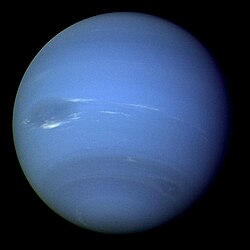Portal:Radiation astronomy/Resource/23
Blues
[edit | edit source]
Blue astronomy is focused on the wavelength range 450-475 nm.
Stars are often referred to by their predominant color. For example, blue stragglers are found among the galactic halo globular clusters.[1] Blue main sequence stars that are metal poor ([Fe/H] ≤ -1.0) are most likely very different in origin from blue stragglers.[1]
"[G]round-based UV [and blue astronomy] is a powerful facility for [the] study of [the] chemical evolution of [the] early Galaxy."[2] UV and B astronomy use radiation over the wavelength range 355.0-500.0 nm.[2]
“To date, all of the reported hypervelocity stars (HVSs), which are believed to be ejected from the Galactic center, are blue and therefore almost certainly young.”[3]
A trace amount of methane is also present. Prominent absorption bands of methane occur at wavelengths above 600 nm, in the red and infrared portion of the spectrum. As with Uranus, this absorption of red light by the atmospheric methane is part of what gives Neptune its blue hue,[4] although Neptune's vivid azure differs from Uranus's milder cyan. Since Neptune's atmospheric methane content is similar to that of Uranus, some unknown atmospheric constituent is thought to contribute to Neptune's colour.[5]
References
[edit | edit source]- ↑ 1.0 1.1 Preston, G. W.; Beers, T. C.; Shectman, S. A. (December 1993). "The Space Density and Kinematics of Metal-Poor Blue Main Sequence Stars Near the Solar Circle". Bulletin of the American Astronomical Society 25 (12): 1415.
- ↑ 2.0 2.1 Klochkova, Valentina; Ermakov, Sergey; Panchuk, Vladimir; Zhao, Gang (July 2007). Ana I. Gómez de Castro and Martin A. Barstow. ed. High resolution spectroscopy of halo stars within the spectral region 3550-5000 °A°A, In: UV Astronomy: Stars from Birth to Death. Proceedings of the Joint Discussion n.4 during the IAU general Assembly of 2006. International Astronomical Union. pp. 161. ISBN 978-84-7491-852-6. Bibcode: 2007uasb.conf..161K.
- ↑ Juna A. Kollmeier; Andrew Gould (July 20, 2007). "Where Are the Old-Population Hypervelocity Stars?". The Astrophysical Journal 664 (1): 343-8. doi:10.1086/518405. http://iopscience.iop.org/0004-637X/664/1/343. Retrieved 2012-03-05.
- ↑ D. Crisp; H. B. Hammel (June 14, 1995). Hubble Space Telescope Observations of Neptune. Hubble News Center. http://hubblesite.org/newscenter/archive/releases/1995/09/image/a/. Retrieved 22 April 2007.
- ↑ Kirk Munsell; Harman Smith; Samantha Harvey (November 13, 2007). Neptune overview, In: Solar System Exploration. NASA. http://solarsystem.nasa.gov/planets/profile.cfm?Object=Neptune&Display=OverviewLong. Retrieved 20 February 2008.
